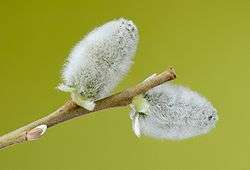Pussy willow

Pussy willow ( Persian: خِلاف بلخی، بهرامج , Arabic: صفصاف مصري، آسيوي )is a name given to many of the smaller species of the genus Salix (willows and sallows) when their furry catkins are young in early spring. These species include (among many others):
- Goat willow or goat sallow (Salix caprea), a small tree native to northern Europe and northwest Asia.
- Grey willow or grey sallow (Salix cinerea), a small tree native to northern Europe
- American pussy willow (Salix discolor), native to northern North America.
Before the male catkins of these species come into full flower they are covered in fine, greyish fur, leading to a fancied likeness to tiny cats, also known as “pussies”. The catkins appear long before the leaves, and are one of the earliest signs of spring. At other times of year trees of most of these species are usually known by their ordinary names.
Cultural traditions
The many buds of the pussy willow make it a favourite flower for Chinese New Year (Lunar New Year). The fluffy white blossoms of the pussy willow resemble silk, and they soon give forth young shoots the color of green jade. In Chinese tradition, this represents the coming of prosperity.[1] Towards the Lunar New Year period in spring, stalks of the plant may be bought from wet market vendors or supermarkets.
Once unbundled within one's residence, the stalks are frequently decorated with gold and red ornaments - ornaments with colours and text that signify prosperity and happiness. Felt pieces of red, pink and yellow are also a common decoration in Southeast Asia.
Xie Daoyun's comparison of snow and willow catkins is a famous line of poetry and is used to refer to precocious young female poets.
The flowering shoots of pussy willow are used both in Europe and America for spring religious decoration on Palm Sunday, as a replacement for palm branches, which do not grow that far north.
Ukrainian and Russian Orthodox, Ruthenian, Polish, Czech, Slovak, Bavarian and Austrian Roman Catholics, Finnish and Baltic Lutherans and Orthodox and various other Eastern European peoples carry pussy willows on Palm Sunday instead of palm branches. This custom has continued to this day among Ukrainian Orthodox Church, Romanian Orthodox, Russian Orthodox, Ruthenian Catholic, Ukrainian Catholic, Kashubian Catholic and Polish Catholic emigrees to North America. Sometimes, on Palm Sunday they will bless both palms and pussywillows in church. The branches will often be preserved throughout the year in the family's icon corner.
Pussy willow also plays a predominant role in Polish Dyngus Day (Easter Monday) observances, continued also among Polish-Americans, especially in the Buffalo, New York area.
In popular fiction
In the book The Best Christmas Pageant Ever by Barbara Robinson the character Imogene Herdman argues with a girl named Alice over which of them will play the Virgin Mary in their school's upcoming Christmas Pageant. Imogene threatens to stick a pussy willow down Alice's ear where no one would be able to reach it. She said "And it'll sit there and grow and grow and grow. So for the rest of your life, there'll be a pussy willow bush growing out of your ear." [2]
In the film Serial Mom, pussy willows play a prominent role in a key part of the film, as the titular character, Beverly Sutphin, begins leaving clues to her identity for neighbour Dottie Hinkle.
Notes
- ↑ http://www.chineseparade.com/pdf/fruits_flowers_brochure.pdf
- ↑ ISBN 9780060250447